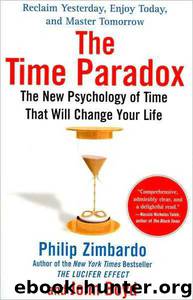The Time Paradox by Philip Zimbardo & John Boyd

Author:Philip Zimbardo & John Boyd [Zimbardo, Philip]
Language: eng
Format: mobi
Publisher: Atria Books
Published: 2008-08-04T20:00:00+00:00
part two
MAKING TIME WORK FOR YOU
seven
TIME, YOUR BODY, AND YOUR HEALTH
More Than Your Biological Clock Is Ticking
TIME HEALS ALL WOUNDS—MORE OR LESS
Over two hundred years ago, the renowned botanist Carolus Linnaeus built—or rather, planted—a living clock, carefully selecting varieties of plants that open and close their flowers at predictable times, arranging them in a circular pattern, each segment corresponding to the number of an hour. His flower clock told time accurately to about thirty minutes, which was not bad by eighteenth-century standards.1
As Linnaeus and others recognized, even plants synchronize their functions to the world around them, tracking the movement of the sun across the sky by opening and closing their flowers or leaves in harmony with it and with the cycles of insects that pollinate them. We live within time, but time also lives within us, as it lives within all living things.
Natural clocks are all around you—the migration of animals, the passing of the seasons, the phases of the moon, and your own bodily processes all mark the passage of time. You can use the beats of your heart to count seconds and menstrual cycles to count months. Even the family pet helps us keep time: God help the cat owner who is late for a feeding.
The physiologist, physician, and Nobel Prize winner Ivan Pavlov was more of a dog person. He noticed that dogs in his research laboratory began to salivate in expectation of being fed.2 His observation began in a curious way. One morning the notoriously punctual and demanding Pavlov was excoriating a research assistant for being ten minutes late for work. The year was 1917, and the assistant had run into a roadblock set up by revolutionaries who had barricaded his usual thoroughfare, forcing him to detour. That was not a sufficient excuse for Dr. Pavlov, who was furious when the assistant finally arrived. But he noticed that the laboratory dogs they were studying had begun to salivate when they heard the regular, consistent sound of the assistant’s footsteps coming into the laboratory, even before they saw him preparing their meal. Pavlov seized on this observation of “psychic secretions,” as he called them, as evidence of a new behavioral law: conditioned reflexes. The dogs had learned to respond “conditionally” to neutral or irrelevant events that signaled the approach of the real thing, tasty food in the mouth. Timing had led them to associate certain events with other events. Virtually all animals—single-celled organisms as well as humans—are conditioned to react in predictable ways, some of which we can modify and some of which are more difficult to change.
Rats and pigeons, too, can be conditioned to keep time. In now classic studies, the psychologists John Watson3 and B. F. Skinner4 trained rats and pigeons to press a lever in order to release food pellets. Some animal subjects were given a food pellet every time they pressed the lever, while others were given a pellet after a fixed amount of time had passed since they had received the last pellet.
Download
This site does not store any files on its server. We only index and link to content provided by other sites. Please contact the content providers to delete copyright contents if any and email us, we'll remove relevant links or contents immediately.
The Four Agreements by Don Miguel Ruiz(5510)
Flow by Mihaly Csikszentmihalyi(4052)
The Four Tendencies by Gretchen Rubin(4024)
You Do You by Sarah Knight(4024)
Adulting by Kelly Williams Brown(3669)
The Hacking of the American Mind by Robert H. Lustig(3579)
A Simplified Life by Emily Ley(3569)
Right Here, Right Now by Georgia Beers(3497)
The Power of Positive Thinking by Norman Vincent Peale(3448)
The Art of Happiness by The Dalai Lama(3382)
Ikigai by Héctor García & Francesc Miralles(3141)
The Little Book of Hygge by Meik Wiking(3080)
The French Women Don't Get Fat Cookbook by Mireille Guiliano(2983)
The Heroin Diaries by Nikki Sixx(2930)
The Choice by Edith Eva Eger(2895)
Why Buddhism is True by Robert Wright(2826)
The Courage to Be Disliked by Ichiro Kishimi & Fumitake Koga(2796)
Make Your Bed by William H. Mcraven(2677)
Spark Joy by Marie Kondo(2675)
